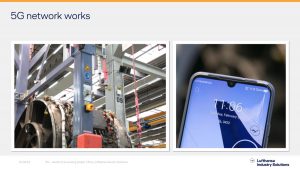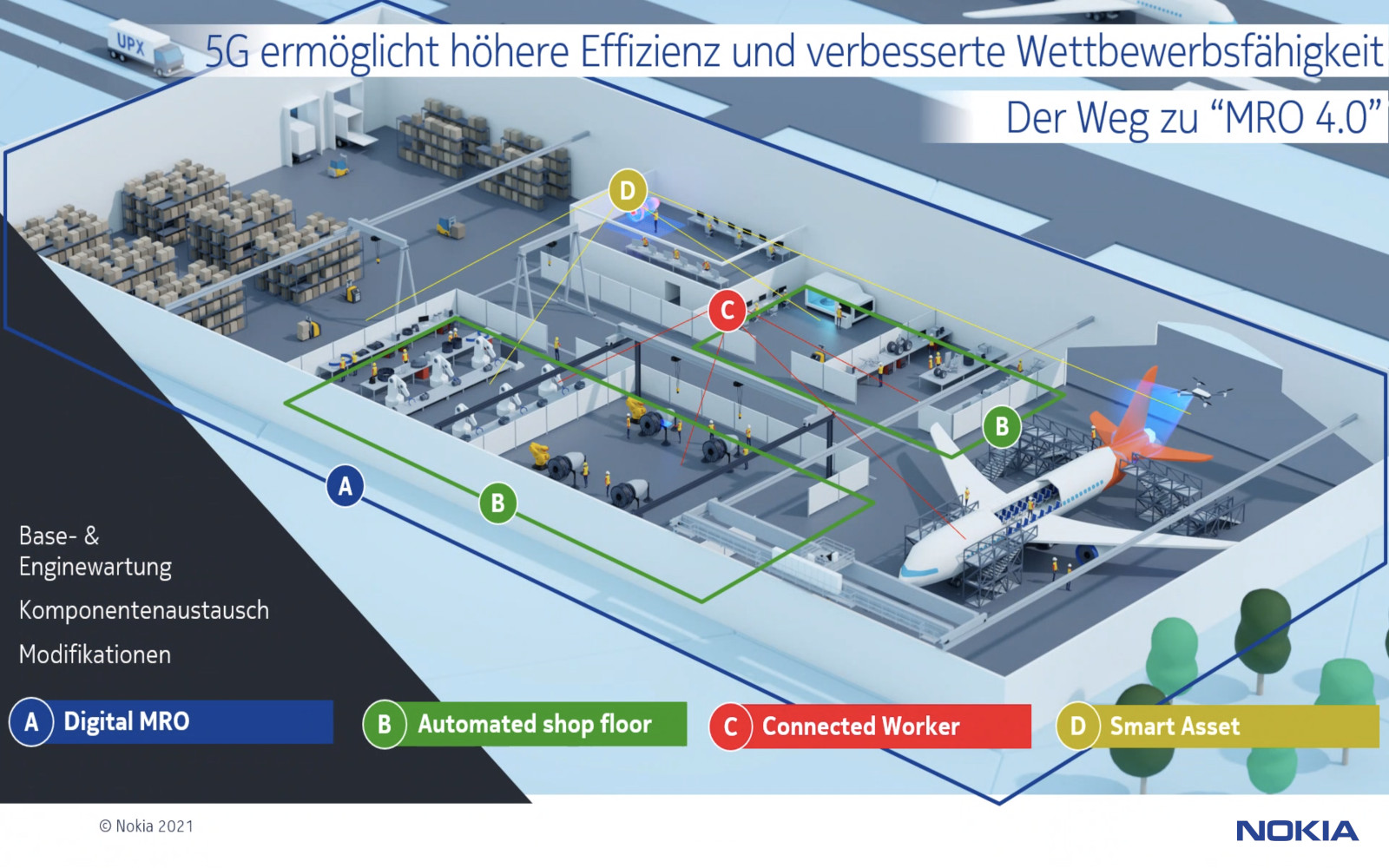Sponsors Article
Lufthansa 5G campus networks go into normal operation
One of Lufthansa’s campus networks covers engine maintenance. (Source: Nokia)
Lufthansa Technik operates no fewer than two campus networks at its Hamburg site. After little more than a year, they have already proven themselves so well that they are now being firmly integrated into normal operations. Why 5G is faster in the dark and other findings from Lufthansa’s practical tests also provide other industrial companies with important information when setting up their own campus networks.
At the beginning of 2020, Lufthansa Technik launched a 5G campus network in engine inspection together with Nokia. The so-called “Virtual Table Inspection” allows customers to participate remotely in the inspection of engine parts instead of traveling to Hamburg and accompanying the work on site. Using a mobile device, clients are guided through the engine workshop and can communicate in real time with the engine mechanics carrying out the work via a video stream. Crucially, the removed parts can be examined on screen in high resolution, enabling customers to make informed decisions about the maintenance job.
What no one could have known at the start of this pilot project: Just a few weeks later, Germany and half the world went into Corona lockdown, travel became impossible, and Virtual Table Inspection was the only way to continue engine maintenance with virtually no restrictions for customers.
The second campus network – set up in cooperation with Vodafone – is used for aircraft interiors. Lufthansa’s VIP division specializes in providing aircraft cabins with customized interior fittings. With the help of augmented reality (AR), the later fittings can already be visualized from the 3D design data in the still empty aircraft fuselage in order to detect potential problems at an early stage and to check during the course of the work whether the realization corresponds to the customer’s wishes.
Lufthansa: Network architecture crucial
Maik Voigt, Lufthansa Technik, and Dr. Claudius Noack, Lufthansa Industry Solutions, are jointly managing the project to introduce 5G at the Lufthansa site. The fact that the high-resolution images from the inspection as well as the AR application in combination with 3D construction data require a high bandwidth was just one of the criteria that tipped the scales in favor of a 5G campus network.
This could possibly have been achieved with other radio standards, such as the latest WLAN variant WiFi 6. On the other hand, there was no alternative when it came to the network architecture offered by the new mobile communications standard. High transmission power, full control of which bandwidths are provided for downloads and uploads, and reliable roaming that guarantees cell changes without interruptions are just some of the features of a 5G network for industry.

The inconspicuous white box supplies the hall with Lufthansa’s own private network, as evidenced by the identifier on the smartphone. (Source: Lufthansa)
In order to use its full functionality while enjoying the greatest possible flexibility, it was essential to set up their own campus networks and not rely on public networks or a hybrid model, Voigt explained when presenting the project.
However, a conscious decision had been made to set up one network in cooperation with a hardware manufacturer, the other together with a network provider, in order to be able to compare the different experiences and derive findings for future projects. As the two project managers confirmed, hybrid networks are also used elsewhere at Lufthansa. This depends on the use case in each case, but they are not disclosing any details at present.
5G KPIs put to the test
To test the practicality of 5G technology in general and its own 5G campus networks in particular, Lufthansa engineers developed a series of use cases. These were accompanied by countless measurements, especially of bandwidth, signal strength, latency and reliability of the connections.
The challenges were enormous. After all, the technology had to work both in open spaces and in halls, had to cope with metal surfaces of buildings and in the skin of aircraft, and in addition had to cope with different transmission and reception technology. In the end, the results were so positive that the 5G campus networks and associated applications are no longer pilot installations, but are now integrated into regular MRO (maintenance, repair and overhaul) operations.
Angling and stumbling blocks on the way to 5G
In addition to the positive results, the two Lufthansa project managers also revealed highly exciting findings that can also benefit other industrial companies.
- Network: The two campus networks are 5G private networks in band n78, i.e. in the range of frequencies reserved for industry from 3.7 to 3.8 GHz, designed as standalone networks according to Release 16 of the 5G SPECIFICATION of the 3GPP.
- Routers: Lufthansa’s transmission and reception technology currently consists partly of prototypes and pre-series models that are not yet available on the market. Industrial-grade devices are currently still few and far between. However, there is probably also great interest on the part of router manufacturers to be represented in pilot projects such as those of Lufthansa and thus to gain first-hand insights into customer requirements and practicality. In addition to routers, 5G-compatible modems with USB-C port are also used.
- Smartphones: The first devices that Lufthansa had procured for the practical test soon had to be retired again. Although they worked successfully in pre-tests, they could not cope with the final network installation – as a standalone version. As before, you have to make sure that the industrial band n78 is supported. Another stumbling block is the security measures of smartphone manufacturers. Some of these determine by whitelist which networks the devices are allowed to log into. A private network that cannot be assigned to any of the usual mobile phone providers is not accepted by some smartphones – including devices from a large manufacturer, as lufthansa had to learn.
- Range and bandwidth: The coverage of the terrain was surprisingly good in some cases. Thus, the 5G network could also be used in a hall in which no own antenna technology was installed. However, the bandwidth then visibly decreases. The network technicians experienced a surprise when measuring the reception inside the aircraft. First finding: In the dark, the available 5G bandwidth is significantly higher – it was only 5 percent below the value outside the aircraft, while with onboard lights on, the bandwidth decreased by 32 percent. The solution to the riddle lay in the ballasts of the old fluorescent tubes, which were installed in the aircraft used for the test. These generated strong electromagnetic interference, which affected the 5G network.
- Cost-effectiveness: As is so often the case with digitization projects, in the case of the 5G campus network, the realization has matured that only the combination of several use cases justifies the investments. One example is smart devices that can be found via 5G location. So far, devices have been lost on the extensive site again and again, but the costs for the new procurement are not so high that it would be worthwhile to install a 5G campus network for it. However, if the network is already there, costs can be saved very easily with this use case.
Basic details about the project will be provided in a webinar from September 2020. If you register here, you can access the recording of the one-hour event.


